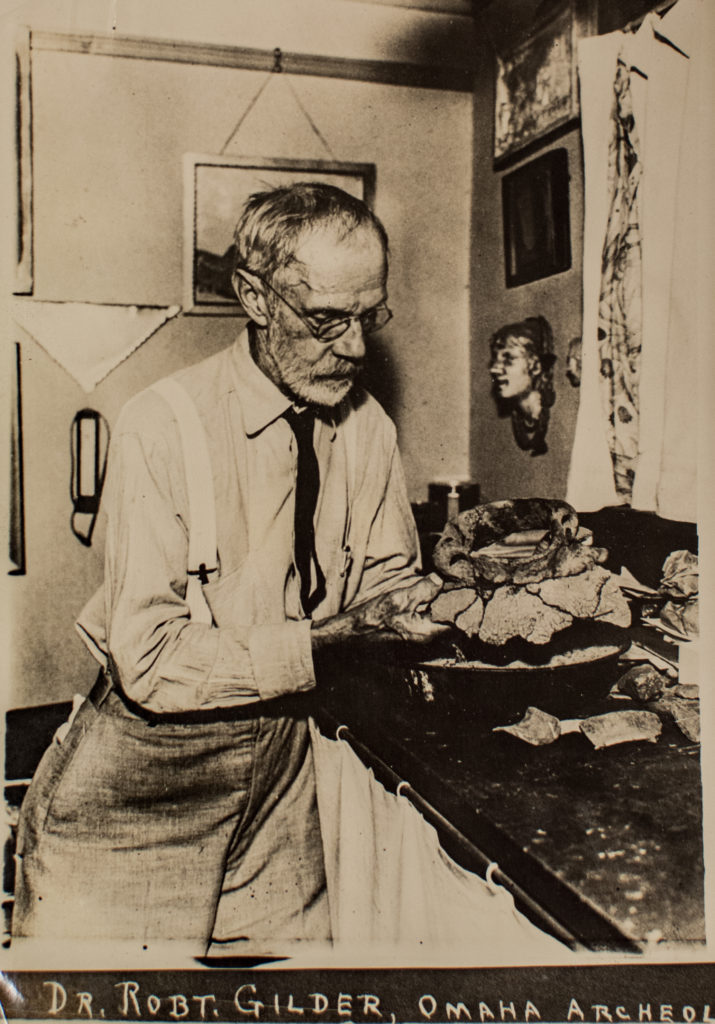Nebraska Phase People through the Work of Robert Gilder
 Have you ever had someone say to you, “Where is home?” Your response might be the naming of a city or state which is a combination of houses, stores, streets, schools, churches, etc., that provide the structure and fabric of life for those of us who live here along the Missouri River in 2018. Another group of people lived here from 1000 AD to 1400AD and called these ridges, ravines, and wetlands home as well.
Have you ever had someone say to you, “Where is home?” Your response might be the naming of a city or state which is a combination of houses, stores, streets, schools, churches, etc., that provide the structure and fabric of life for those of us who live here along the Missouri River in 2018. Another group of people lived here from 1000 AD to 1400AD and called these ridges, ravines, and wetlands home as well.
They lived here for approximately 400 years very successfully. Their needs for food, water, and shelter, were met remarkably well. Their ingenuity for using the resources at handled them to create tools for hunting, farming, and fishing. They used all the parts of an animal for a wide variety of household goods and for clothing. They found materials from Earth-like clay, granite, chert, and used them to construct cooking utensils like knives and scrapers for processing game. They preserved and stored food for use over long, cold winters. They built lodges from natural materials they found in this area and assembled those dwellings in a pattern that included a south facing entrance, 4 main posts in the center with a central fire pit and a rectangular shape. They were insulated enough to protect them from winter cold and summer heat.
How do we know about these people and their successful life here almost a thousand years ago as they left no written history? We know it through the observations and curiosity of a gentleman who walked these same ridges, ravines and wetlands at the turn of the 20th century. Robert Fletcher Gilder, a newspaperman by trade, had two interesting hobbies, painting and archeology. Robert Gilder had all the skills and intuitions he needed to be a very good amateur archeologist.
My favorite poet, Mary Oliver has a poem entitled, Instructions for Living a Life. It is very simple:
Pay attention.
Be astonished.
Tell about it.

 Robert Gilder did just that. He paid attention to the depressions in the landscape along these ridges. He explored those depressions and discovered fascinating artifacts that amazed, or astonished him. He learned more about archeology from some of the most accomplished archeologists of the day and he told the world about it in the many articles that he wrote.
Robert Gilder did just that. He paid attention to the depressions in the landscape along these ridges. He explored those depressions and discovered fascinating artifacts that amazed, or astonished him. He learned more about archeology from some of the most accomplished archeologists of the day and he told the world about it in the many articles that he wrote.
Gilder was not the only one to research the background of the Nebraska Phase People. There have been three known archeological excavations here on the property that Fontenelle Forest now owns. The work of Gilder took place between 1907 and his death in 1940 at age 84. An excavation by the Nebraska State Historical Society took place here under the supervision of A.T. Hill and Paul Cooper in 1937. In 1998, Dr. Eric Kahldahl, as part of his doctoral work at the University of Nebraska conducted a third excavation. Glenwood, Iowa has also been the site of recent archeological work of these same people.
The life-ways of these people is an interesting story to tell. Without question, we have to look to a longtime employee, Gary Garabrandt, for keeping the facts and the story alive. He accumulated a large of selection of historic documents about Gilder and others and stored them in Fontenelle Forest’s archives. The history of Gilder and Nebraska Phase People has been incorporated into interpretive signs and trail guides for some time.
In our research within the archives, we began to wonder where the artifacts from those excavations were currently being stored. In researching, the Gilder artifacts we found that in about 1912 he  gave some of his collection to the Omaha Public Library. In 1949 they transferred them to Joslyn Art Museum and from there they went to the University of Nebraska State Museum in Lincoln in 1974.
gave some of his collection to the Omaha Public Library. In 1949 they transferred them to Joslyn Art Museum and from there they went to the University of Nebraska State Museum in Lincoln in 1974.
Some of the staff from Fontenelle went to Lincoln to see the artifacts in 2016 and again in 2017. We were thrilled with what we say and immediately began to strategize as to how we might bring some of the artifacts to Fontenelle Forest in an effort to help our visitors learn about the successful life of these pre-contact people who lived here so long ago. After that trip and a second trip, we began to talk about how we could bring some of those artifacts here to the Forest and tell the story of NE Phase People. After quite a few conversations and lots of work with many people, we are very pleased to open this exhibit today.
Our connection to these people through their remaining artifacts has something to say to us about how we too might live successfully in our historical time. Look at the artifacts, let them and their stories touch you, and think about the ways in which you might connect with these people.
We hope you enjoy your time with these artifacts and that they might leave you wondering about their lives and your life and the connection between the two.
Catherine Kuper, volunteer archivist


